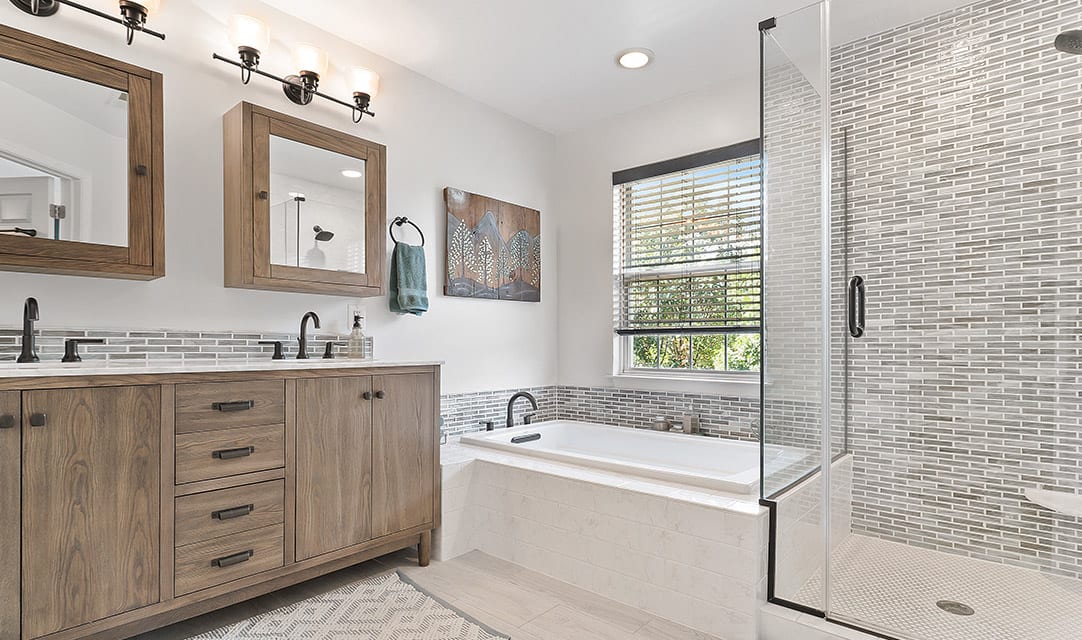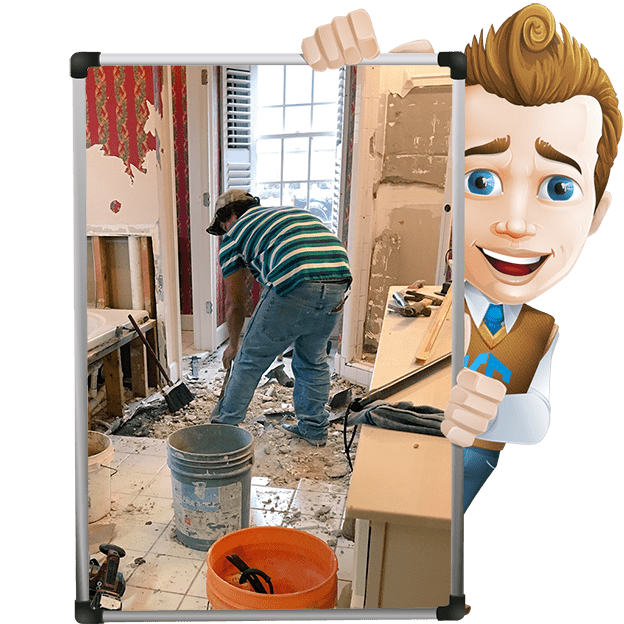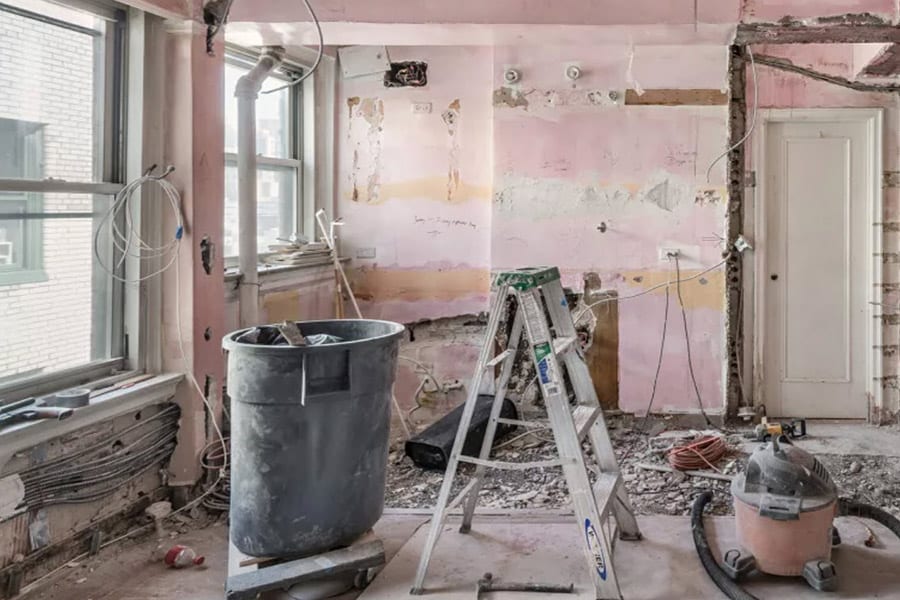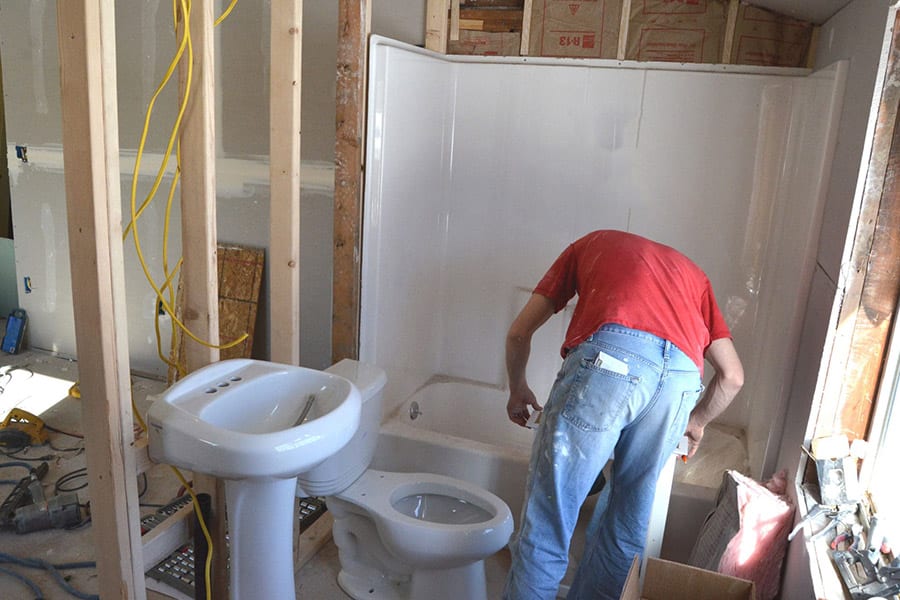
Do-It-Yourself Bathroom Remodels: A Few Tips From the Pros
Ben from South Denver asks:
I’m thinking of tackling my own bathroom remodel. Can you pass on any advice?

“You’ll want to avoid this!”
Sure, Ben. We would guess that half the homeowners in Colorado want to have at least one bathroom remodeled. The other half have already done so recently. But how many of these either were or are intended to be do-it-yourself (DIY) bathroom remodels?
A DIY bathroom model is one that is done, at least in part, without the assistance of one or more bathroom remodel contractors. Kitchen Concepts recommends a degree of caution when taking this approach. We will look at both the bathroom remodeling and renovation processes … which are different from each other … and make recommendations to amateur do-it-yourselfers as to when to use professional contractors.
Really?
Bathroom Remodel vs. Renovation
Remodeling and renovating a bathroom are two different projects that are often combined into one. However, to do the full project, you likely will need to hire both a bathroom remodel contractor and a bathroom renovation contractor.
Here’s why:
What is a Bathroom Remodel?
To “remodel” something means to change its structure or form. This applies especially to buildings. When remodeling a bathroom, you’re redesigning its overall look … possibly moving or replacing fixtures, installing new wall and/or floor tiles, painting walls and trim, adding shelves or wall fixtures, and redecorating in general.
Much of this can be a DIY bathroom remodel, including some of the prep work (removing old tiles, for example). And a lot can be done at the finishing end of things, such as painting, placing wall fixtures, etc. However, it’s important to bring in both design and plumbing experts in to work with you when planning the project. We’ll discuss this more below.
What Is a Bathroom Renovation?
Renovation is defined as restoring “to a former better state (as by cleaning, repairing, or rebuilding).” As mentioned, many bathroom remodels are combined with renovations since it makes practical and financial sense to do all the construction work at the same time. If, for example, you need to reset a toilet, this would be a good time.
In the following paragraphs, we’ll focus on a bathroom remodel that will include some renovation elements as well. In other words, we will discuss a “complete bathroom overhaul.” This will require work from you as well as the professional contractors you hire.
The Prep Work for a Bathroom Remodel
Planning the Project
The first stage of a bathroom remodel is to sketch out what you want the new bathroom to look like. You should begin by sketching out features that will fit the space available. Be sure to indicate any fixtures you want to relocate.
Then, try to set up a time when you can meet with both a designer and a plumber so they can help bring your ideas to fruition and/or recommend any necessary adjustments with everyone there to weigh in.
Together, you can all agree on a realistic cost estimate for the entire project. The designer and plumber should be able to estimate the cost of any subcontractors (e.g., flooring) based on their prior experience.
The Messy Prep Work
If you really want to DIY your own bathroom remodel, go ahead and get started tearing things apart. Why not begin by removing the flooring? If you can get it all taken up without any surprises, that’s great! But don’t be surprised if there are some surprises. Remember, it’s a bathroom, and thus has had a lot of water and other substances penetrating the surfaces ever since the last remodel (or original construction).
You are likely to discover some rotting of and between the subfloor and floor joists that must not be ignored. This is your first indication that it might be time to bring in the professional contractors.
A likely scenario is that a plumber will need to come in and repair or replace parts of the plumbing that have lain untouched beneath the surface flooring.
And if you were planning to replace any of the fixtures (toilet, sink, tub/shower), this would be a good time to get started with that, so the plumber can deal with what goes under the flooring before that flooring is replaced. In fact, the flooring should not be replaced until the final stages of the remodeling project. If the project gets messy, you wouldn’t want that to ruin a new floor.
The Main Remodeling Project
This is the part where the contractors will do their part. And no one but the most experienced DIYers should be involved at this stage (and only if the contractors will allow it). This is the work of professionals. Here are some reasons why:
- They are the experts on appropriate materials to use in a bathroom to avoid mold, leaks and seepage, and even pest encroachment.
- They will know which fixtures can be repaired and which will need to be replaced, as well as how to install them properly (including roughing in a toilet).
- They know how to lay flooring materials and position wall tiles.
- They know what to do if they discover a previously unknown (and possibly dangerous) problem.
- And, among other things, they will keep you updated on the progress of the project in ways that make it seem far simpler than it actually is.
- Remember as well that if this were a DIY project, it’s likely that (1) you would waste money by making mistakes and (2) you would spend money to have a contractor come in to deal with either mistakes or hidden problems.
If the right contractor(s) are there from the start, there will be few if any mistakes, they will “eat” the cost of their mistakes, and they will be relatively unperturbed by unexpected discoveries and just take care of them.
The Finishing Work
After the new floor has been put in and the work has been checked over and inspected if necessary, then it’s back to you, the do-it-yourselfer. And these are things for which DIY can save you money. They include:
- Painting the walls (and ceiling if necessary).
- Installing and painting the trim.
- Putting up wall fixtures such as hooks and towel racks.
- Putting up shelves or shelving units.
- And taking care of any other desired finishing touches.
And the good thing about this is that, when all is said and done, you are responsible for the most noticeable features of your new bathroom!
DIY Bathroom Remodel: A DIY Don’t
A lot can be learned from DIY projects … they are a worthwhile pursuit, especially when they can save you money. For most of us though, it takes a good while before we have enough experience to save much money or time.
If you’re interested in what the contractors are doing, find out if they’d mind having you look on and ask questions periodically. Then read up later on what you observe. This will allow you to learn without expending all your resources.
Once your new bathroom is ready, you’ll be glad you hired professionals for the work. So if you live in the Denver-Colorado Springs area and are thinking about a bathroom remodel, let us know. We’d be happy to show you what Kitchen Concepts can do!
“Time to call the pros?”
Does it all sound like a bit of a hassle? Contact Kitchen Concepts and let us show how truly affordable using a proven professional is! We have offices in Denver (720.725.0000) and Colorado Springs (719.330.5474).
Ask a question or request your free estimate!
Call (719) 330-5474
or
complete the form below.

Serving Denver, Colorado Springs and surrounding communities!
Search The Site
Translate This Page
 |
Need landscaping? Visit our Landscape FX sister company's website by clicking here! |




